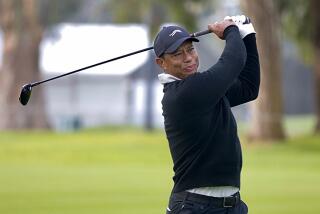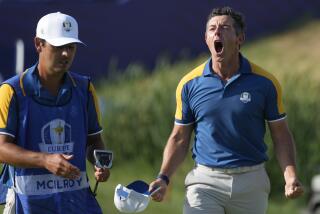Youth May Be Key to Ryder Cup
- Share via
Tom Lehman stood in the rough at the edge of the 18th fairway at the 1995 Ryder Cup, the wind stinging his face with rain, his heart pounding as he pulled a five-iron from his bag and faced the 205-yard shot.
The alternate-shot match of Lehman and Corey Pavin against Nick Faldo and Colin Montgomerie was even going to the final hole, the Americans having squandered a 4-up lead.
It was the first match of the competition and the first Ryder Cup match Lehman had played. He had never felt pressure like that.
“Before I hit the shot, I said, ‘Corey, I need a pep talk. I’m not hitting it too well,”’ Lehman said. “Corey said, ‘Pick your best club, get committed and swing really hard.”’
Lehman knocked it to 40 feet and when Faldo and Montgomerie couldn’t make par, the Americans needed to get down in two to win the match.
“After I hit it, I’m thinking, ‘Don’t make me putt,”’ Lehman said. But he made a 4-footer for the win. It was a career-making hole.
“To hit a shot like that with the heat on . . . ,” Lehman said, still amazed two years later at the pressure. “You just kind of hold your breath. I think maybe I needed to make a 3- or 4-foot putt to win a match to know I can do it.”
Now he knows he can do it, and so does anyone he is playing.
Similar lessons will be learned--probably time and again and at times with more painful results--at the 32nd Ryder Cup, beginning Friday at Valderrama. Golf Club in Sotogrande, on the Mediterranean coast of Spain.
Nine of the 24 players--four of them Americans--will feel Ryder Cup pressure for the first time. Another six--five of those Americans--will be in only their second Ryder Cup.
How those newcomers respond to the challenge of playing for their country will be key to determining if the United States can reclaim the Cup it lost to Europe in Rochester, N.Y., in 1995.
“Playing with a team adds to the pressure,” said Jim Furyk, 27, one of the four American rookies. “You don’t want to let anyone down. Playing for your country--it’s the ultimate honor.”
Tom Kite, the U.S. captain, played in seven Ryder Cups and knows exactly how the newcomers will feel.
“Scared to death,” he said. “There is no way to prepare for it because it comes around only every two years. A player is lucky if he gets to play in two or three Ryder Cups in his career. Very few have played in more.”
Tiger Woods, Justin Leonard, Scott Hoch and Furyk will be playing for the first time. Lehman, Phil Mickelson, Jeff Maggert, Brad Faxon and Lee Janzen will be making only their second appearance.
“I’ve heard all the stories about the pressure at the Ryder Cup--Davis wanting to throw up and all that,” Furyk said. “I expect it to be that way. But you know that the other 23 guys feel the same way you do.”
Only Fred Couples (4), Mark O’Meara (3) and Davis Love (2) have played in the Ryder Cup more than once for the Americans.
“I’m looking for a couple of guys to show some leadership,” Kite said. “Love, Couples, Lehman and O’Meara are my veterans. They’ve all got to play well.”
European captain Seve Ballesteros also has a young team, but he has players with experience, too.
Darren Clarke, Lee Westwood, Thomas Bjorn, Ignacio Garrido and Jesper Parnevik have never played in the Ryder Cup and Per-Ulrik Johannson has played in only one.
Faldo--whose pressured-packed 93-yard wedge to 4 feet on the final hole was the key shot of the European victory in 1995--will be playing in a record 11th Ryder Cup.
Bernhard Langer (8), Ian Woosnam (7), Jose Maria Olazabal (4), Colin Montgomerie (3) and Costantino Rocca (2) all bring a lot of experience to Valderrama. Ballesteros avoided having another rookie on the team when he dropped an injured Miguel Angel Martin from the squad.
“Seve has an unbelievably strong team. And we are at a disadvantage because we don’t know the course,” Kite said of a Valderrama layout he believes requires as much knowledge as Augusta. “We have to be the underdogs.”
Kite rejects descriptions of Valderrama as being an American-style course.
“It is much tighter in terms of trees overhanging the fairways and greens,” he said. “They have a huge advantage because they’ve played it.”
Not only do the Europeans play Valderrama every year in the Volvo Masters, but Montgomerie, Langer, Woosnam and Olazabal have won tournaments there.
Faldo, however, believes the Americans will have an advantage at Valderrama because the greens are fast, much more like those in the United States than the slower European putting surfaces.
“They have some seriously good putters and they are very used to Valderrama-style greens,” said Faldo, who made the team as a captain’s pick after coming off his worst season in major championships in 15 years. “I think we are definitely underdogs.”
Kite offers one final word of warning to U.S. fans: Don’t underestimate European players who are not household names in the United States.
In 1995, crucial points were won on Sunday by Howard Clark, David Gilford and Philip Walton.
“Not only the American fans but the American media tend to underestimate the European players they have not heard of,” Kite said. “These guys can play or they wouldn’t be on the team.”
While a singles matchup like Woods against Faldo would be a TV producer’s dream, the Ryder Cup could very well be decided in matches played by guys like Bjorn, Garrido, Westwood or Clarke.
They, along with Woods, Furyk, Leonard and Mickelson, make this Ryder Cup a compelling competition offering a glimpse of golf’s future.
More to Read
Go beyond the scoreboard
Get the latest on L.A.'s teams in the daily Sports Report newsletter.
You may occasionally receive promotional content from the Los Angeles Times.










